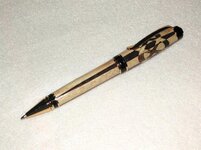Xephius
Member
I have several jigs and setups I thought I would run by the community to get advice on. My hope is someone will see a way I can increase my efficiency or make the process easier. I have already learned a great deal about how to better my stabilization process by posting to the lists, I hope to continue that trend. 
Here is my drilling rig. I ran into several problems in the past. First was using twist bits, they wander off center and made bad cuts in general. I switched to Brad Point for everything I could, and just recently ordered a complete set of metric and standard BP bits. The second problem I had with drilling was the vise. I had tried to use everything from a wood clamp, to a "drill press vise" and always spent a great deal of time adjusting and moving the vise to get it centered. Finally fed up, I went and purchased a 4" cross slide vise from HF. I have been thrilled with the results. I was lucky enough to get a second vise face with the 90 angle holder with the vise. Normally they only come with one, but the sales associate gave me one from the display when I asked about buying a second one.

Next is my celtic knot jigs. I built them based on some plans given to me by Ed at N. Houston Woodcraft store. I had never done a knot, but he said it was easy, so I gave it a try.
My "slicing" jig. The sliced off bit slides out the back once it is cut. I was worried that it would shoot out like a bullet, but it just slips out and I catch it with a glove.

My second slicing jig is setup so I can adjust the with of the laminated layer. I can move the stop with he use of the clamp. You can see a thing slice of wood that has been laminated on both sides with colored wood. It is now the exact thickness of my table saw blade.

Here is the blank cutting jig for knots.

And the results from my first knot...


All said, not perfect, but a great learning experience. I have made several others and now have the spacing perfect so everything lines up just right.
Thoughts on improvements?
-X
Here is my drilling rig. I ran into several problems in the past. First was using twist bits, they wander off center and made bad cuts in general. I switched to Brad Point for everything I could, and just recently ordered a complete set of metric and standard BP bits. The second problem I had with drilling was the vise. I had tried to use everything from a wood clamp, to a "drill press vise" and always spent a great deal of time adjusting and moving the vise to get it centered. Finally fed up, I went and purchased a 4" cross slide vise from HF. I have been thrilled with the results. I was lucky enough to get a second vise face with the 90 angle holder with the vise. Normally they only come with one, but the sales associate gave me one from the display when I asked about buying a second one.
Next is my celtic knot jigs. I built them based on some plans given to me by Ed at N. Houston Woodcraft store. I had never done a knot, but he said it was easy, so I gave it a try.
My "slicing" jig. The sliced off bit slides out the back once it is cut. I was worried that it would shoot out like a bullet, but it just slips out and I catch it with a glove.
My second slicing jig is setup so I can adjust the with of the laminated layer. I can move the stop with he use of the clamp. You can see a thing slice of wood that has been laminated on both sides with colored wood. It is now the exact thickness of my table saw blade.
Here is the blank cutting jig for knots.
And the results from my first knot...
All said, not perfect, but a great learning experience. I have made several others and now have the spacing perfect so everything lines up just right.
Thoughts on improvements?
-X

